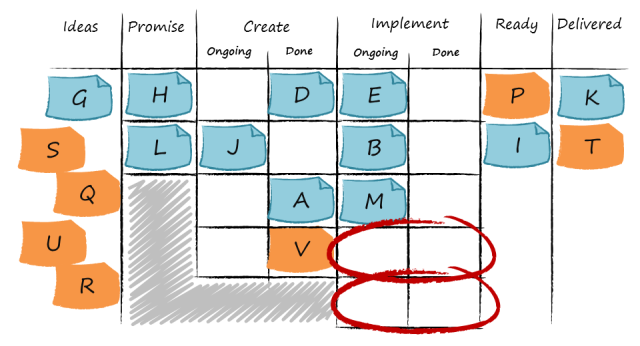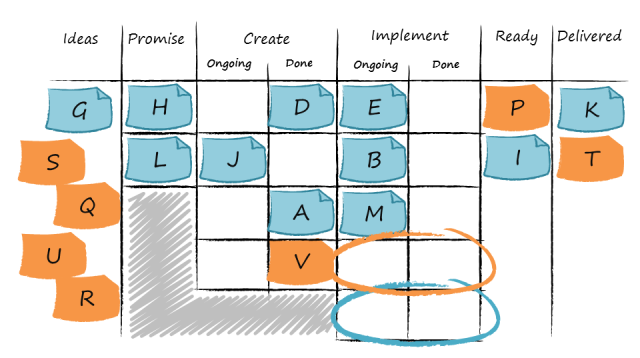A p
articipant of my recent training class told me afterwards of an insight most important to him. “Kanban is not a card, it’s a space.”I received this feedback during a long streak without any blog posts. So I thought, I could log it and share it in a short blog post. If it was useful to one participant, it might be useful to more people in the audience. And not every post must be 500-1000 words long as most of my more popular posts turned out.
Let’s look at the following Kanban board (看板), representing kanban with slots.

The “Implement” column has two available slots. They are kanban (かんばん) — the permission-giving signals allowing two work items to enter this space, representing the available capacity in this workflow activity. Looking a bit to the left, “Create-Done”, we find three work items to choose from: D, A, and V. Now we have to make a pull decision: choose two out of these three.
Let’s now look at another board, visualizing the same Kanban system in the same state, but using a different visualization style.

All kanban here are virtual. We figure out their quantity by subtracting the number of cards from the work-in-process limit above each column. Thus the “Implement” column has capacity-space for the same two work items.
Note that the work items or the demand on our delivery process are not equal. They often come from different customers and market segments, with different risks and customer expectations attached. I did the minimum for illustration purposes and used two colours to visualize such distinctions.
Our capacity is also not the same. We may have some degree of specialization or decide to allocate capacity bands to serving certain sources of demand. Let’s look at the following board, the same as the first one, except we decided to use 20% of our implementation capacity (one work item in five) to serve the work item type visualized in orange.

One of our pull decisions follows from our explicit capacity allocation policy: we pull work item V. We have options A and D for another pull decision.
I’m really zooming in here on a very small episode of Kanban training and leaving a lot out of focus: what other visualization styles exist, what are the trade-offs of using each, and a whole week (minus five minutes) of other material. This is because I want to focus on one takeaway.
The cards on the Kanban board are not kanban! The cards represent deliverables, customer requests and needs. The kanban are permission-giving signals, representing the currently available capacity. They can be visualized very obviously with slots or as virtual kanban. In short, they are not cards, they are the spaces.
Source link
